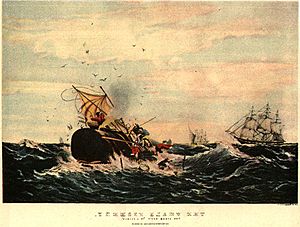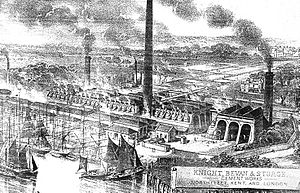Thomas Sturge facts for kids
Quick facts for kids
Thomas Sturge junior
|
|
|---|---|
| Born | 13 July 1787 Southwark St John Horsleydown, Bermondsey, London
|
| Died | 14 April 1866 |
| Nationality | British |
| Occupation | Oil merchant, whaler, ship owner, cement manufacturer |
| Years active | 1800-1866 |
|
Notable work
|
philanthropist and social reformer |
Thomas Sturge (born 1787, died 1866) was an important British businessman. He was an oil merchant, shipowner, and even made cement. He also helped build railways. But he was more than just a businessman. Thomas Sturge was also a social reformer and a philanthropist. This means he worked to make society better and gave money to good causes.
Contents
Early Life and Family Business
Thomas Sturge was born in 1787. He was one of at least ten children. His father, Thomas Sturge the elder, was an oil merchant. Their family business was in Newington Butts, London.
Young Thomas joined his father's business in the early 1800s. Several of his brothers also worked there. Their company, Thomas Sturge & Sons, processed oils. They worked near Elephant and Castle until 1840. Thomas Sturge was also a cousin of Joseph Sturge. Joseph was another famous social reformer.
Oil Merchant and Shipowner
Starting a Whaling Business
By 1816, Thomas Sturge junior was the main boss of the family business. He started buying ships. He sent these ships to the Southern Whale Fishery. This was to get whale oil, seal oil, and spermaceti. These products were then processed and sold in London. He became the main owner of at least 23 ships. Most of them were South Sea whalers.
Quaker Values in Business
Thomas Sturge was a Quaker. His faith guided how he ran his business. He tried to hire Christian captains for his whale ships. His sailing instructions told captains how to treat their crews well. Each of his ships had a small library. At least five ships also had a doctor.
One of these doctors was Dr. Thomas Beale. He later wrote a book called The Natural History of the Sperm Whale (1839). He dedicated this book to Thomas Sturge. The famous novel Moby Dick by Herman Melville used ideas from Dr. Beale's book. The book also inspired three paintings by J. M. W. Turner.
Helping Others: Social Reformer and Philanthropist
Supporting Seamen
Thomas Sturge cared about helping people. By 1818, he was part of a group that helped sailors in need. In 1821, his company gave money to buy a ship. This ship would be a floating hospital for sick sailors. The Seamen's Hospital Society was started that year. Thomas Sturge was on its management committee.
Fighting Against Slavery
He was also a member of the Anti-Slavery Society. He gave a lot of money to help end slavery. Many Quakers, like Thomas, were against slavery. His cousin, Joseph Sturge, was also a well-known anti-slavery activist.
Other Charitable Work
Thomas Sturge regularly gave money to many other good causes. He helped missionaries travel to the South Seas on his whaling ships. He also supported the education of deaf people.
Exploring Antarctica
In 1838, Thomas Sturge joined other London shipowners. They bought two ships: the Eliza Scott and the Sabrina. These ships went to the Antarctic. Their mission was to find new islands with seal colonies.
They discovered a group of five new islands. These were named the Balleny Islands. Each island was named after someone who helped fund the trip. Sturge Island is one of them. It is 23 miles long and 6 miles wide. It is always covered in snow and ice.
Making Cement
In 1837 and 1838, Thomas Sturge bought land near Northfleet on the River Thames. He spent over £9,000 on this 74-acre plot. He built a cement factory there to make Portland cement. Construction of the cement kilns began in 1851. Production started two years later, in 1853.
Investing in Railways
Thomas Sturge was also interested in new railways. In 1842, he spoke at a meeting to support building the Dean Forest and Gloucester railway line. He became a big investor in the Eastern Union Railway Company. He was also a major investor and director of the West Hartlepool Harbour and Railway Company.
Later Life and Legacy
In 1842, Thomas Sturge left London. He moved to Northfleet and bought a large house there. Thomas Sturge passed away on April 14, 1866. He never married. Most of his wealth, about £180,000, went to his brother and business partner, George.




